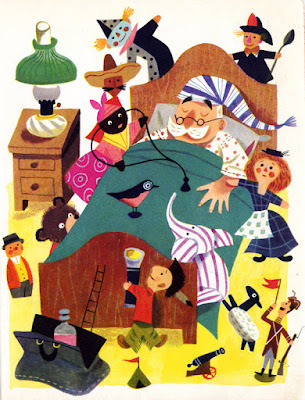Powwow Day
Written by Traci Sorell (Cherokee)
Illustrated by Madelyn Goodnight (Chickasaw)
Published in 2022
Publisher: Charlesbridge
Reviewed by Jean Mendoza
Review Status: Highly Recommended
Powwows are an Indigenous tradition that many non-Native readers (child or adult) have at least heard of, though misconceptions abound. Most seem to emphasize the entertainment -- the drums, the singing, the dancing -- with little awareness of the reasons Native people hold powwows in the first place.
That awareness can be gained from several contemporary picture books by Native creators. There's White Earth Anishinaabe author Marcie Rendon's photo-essay
Powwow Summer: A Family Celebrates the Circle of Life (1996/2013; photos by Cheryl Walsh Belleville). The protagonist of
Jingle Dancer (2000/2021) by Cynthia Leitich Smith (Muscogee) gets ready for a powwow, and in
Bowwow Powwow (2018) by Brenda Child (Red Lake Ojibwe), the main character dreams about a highly unusual powwow. And I don't want to forget
Josie Dances (2021) by Denise Lajimodiere (Turtle Mountain Band of Ojibwe), in which a girl, her mom, and three other family members prepare for her to dance at the next powwow.
A 2022 addition to that list is Powwow Day, by Cherokee author Traci Sorell and illustrator Madelyn Goodnight, Chickasaw.
Here's what the book jacket says about Powwow Day:
Today is powwow day. Then River remembers: no dancing for her this year. Even though she's feeling better lately, she's still not strong enough. Maybe she can at least dance Grand Entry? Join River and her family as they enjoy a cultural tradition -- their tribal powwow. As River tries to make peace with her temporary limitations, she reminds herself that her beloved jingle dress dance is to honor the Creator, the ancestors, and everyone's health -- including her own.
And here are 4 reasons why AICL strongly recommends Powwow Day.
Reason #1: The story line is emotionally resonant.
Many children have had to temporarily stop doing something they love due to illness or injury. It won't be hard for them to empathize with River's sadness, frustration, and (ultimately) hope as she stands apart from activities that mean a great deal to her.
Reason #2: The illustrations emphasize a Native child's personal experience of a public traditional event.
Every time I look through this book, I find something else to appreciate about Madelyn Goodnight's depictions of the characters and the event. Tenderness and a sense of loving community are on every page. Illustrations and photos of powwows can feel impersonal or disconnected from the individuality of the people pictured. But Goodnight's powwow-goers have a range of skin tones, facial shapes, hair styles, and expressions. And several of them wear glasses! Each dancer's regalia is unique.
Yes, there's beautiful, bright, sound-filled spectacle, but the personal elements are foregrounded, showing River's deeply-felt connections to her family and community. No one, least of all River, is there to be entertained.
Reason #3: It's tribally specific, indirectly.
Powwow Day doesn't name River's Native Nation, but the author's use of the term "tribal powwow" suggests that this event may be smaller, more local, than the intertribal powwows that draw participants and audiences from far and wide. The back matter is more specific about the tribal origins of powwows and of the jingle dress dance. In her note, Traci Sorell also makes clear that she didn't attend powwows until college; they were not part of her Cherokee heritage. That's an important point to make for many non-Native readers who tend to assume that all tribes had powwows, historically (a variant of the "Native tribes are all alike" stereotype).
Reason 4: It doesn't have to stand alone.
Sharing Powwow Day with children, along with any or all of the other 4 powwow-themed books I mentioned earlier, can begin to give them a multi-dimensional picture of what powwows are like. Kids can watch for details and make comparisons. What does each book say about the jingle dress dance, and other dances? About the drums? What does each main character do to get ready for a powwow? What's depicted in the background at each powwow? (For example, can they spot the rows of portable toilets in Powwow Day? That's a most welcome feature of contemporary powwows.)
If you teach about powwows, we'd love to hear what you're doing, and what place books like Powwow Day have in your planning.
EDITED by Jean 2/10/23: Some cool additional information from author Traci Sorell, via comment on Facebook: "We
do share the tribe in the art on the Grand Entry page. Look for the
black flag behind the eagle staff. It's the flag of the Sault Ste. Marie
Tribe of Chippewa in MI's UP.
The short story
"Secrets and Surprises" I wrote in ANCESTOR APPROVED continues with this
family and begins in the tribe's rez up in the Soo."






















